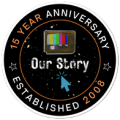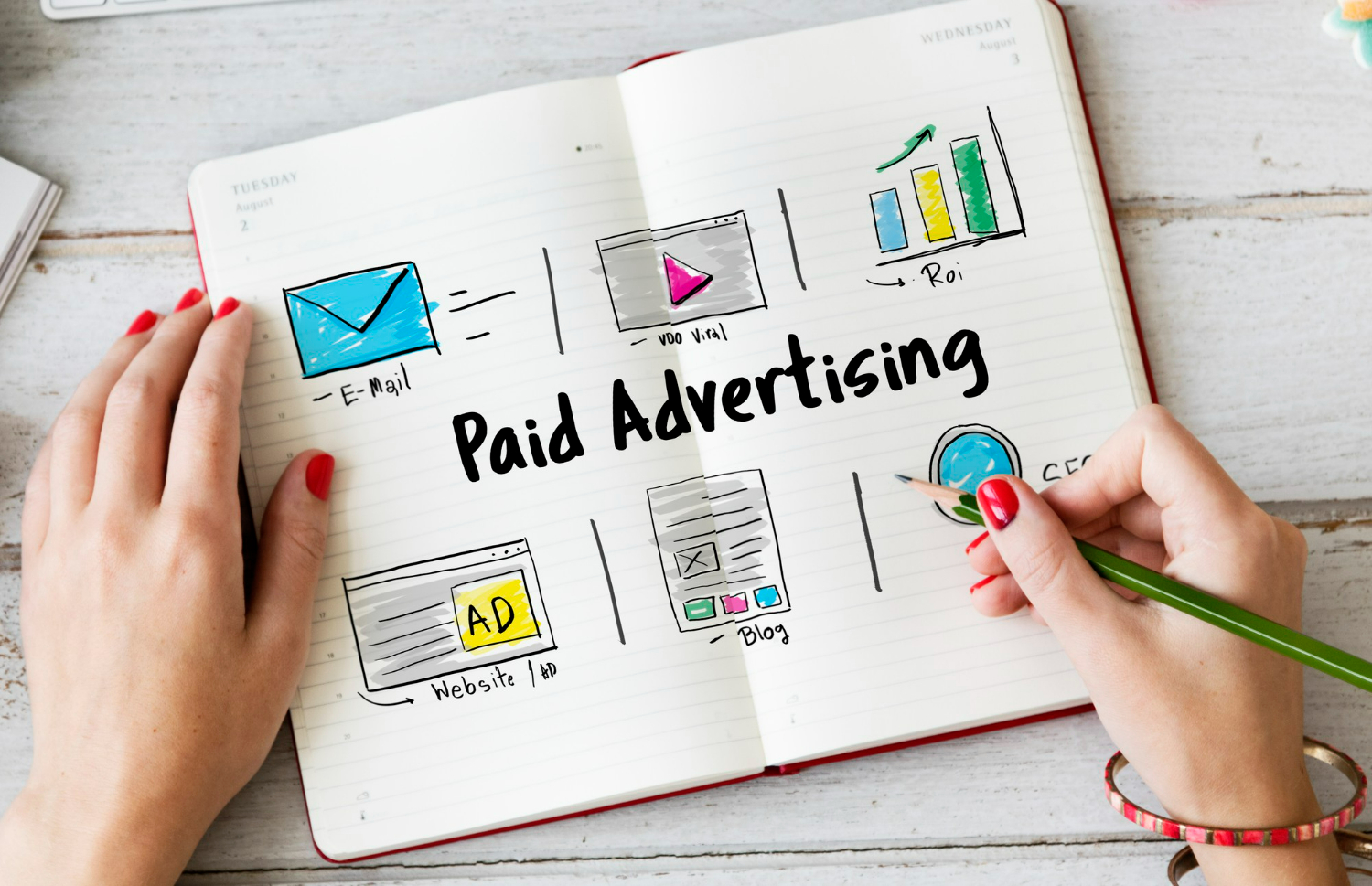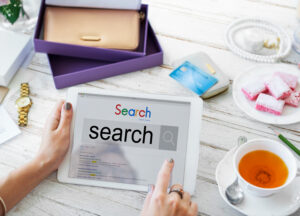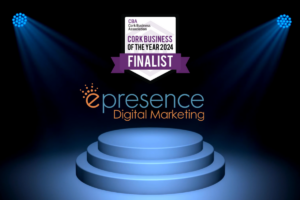THE BASICS OF DIGITAL ADVERTISING
Introduction
It’s important to immediately differentiate between digital marketing and digital advertising. When I talk about digital advertising I am specifically referring to Paid Advertising as opposed to free organic visitors.
Free organic visitors are visitors or followers you have earned on your social media platforms and website through Posting, Engagement, Content Marketing, Blogging, Search Engine Optimisation and other non-paid methods.
Digital advertising is the placement of and paying for specifically designed adverts on a range of digital platforms such as Google Ads, LinkedIn, YouTube, Affiliate Sites or Facebook.
Paid digital advertising is an extremely powerful tool that can be used to boost existing successful organic campaigns and cover existing organic weaknesses.
If you have certain web pages, content or blogs on your website that are doing well and attracting more visitors or sales than others you can use digital advertising to attract more relevant and targeted visitors to these pages and further boost your sales and engagements.
Alternatively, you can use paid advertising to compensate for areas where your organic presence is weak. Setting up a paid campaign is quick and offers virtually instant results compared to building an effective organic presence, which can take months.
If you are launching a new service or product a paid advertising campaign will get the word out there quickly while you build up your organic presence. Paid advertising is also great for time-specific specials or seasonal campaigns that you switch on and off.
As a small company, It may be proving difficult to obtain a good organic ranking on Google Search Results for certain important high-value keywords or phrases that are dominated by the bigger players in the market, a Google Search Ad campaign may be a good alternative in this case to grab a slice of the pie.
Contact Us for your Digital Advertising Requirements, we are a professional Digital Marketing Agency in Cork with over 15 years experience in helping companies all over Ireland achieve their business goals.
Advertising Goals
I find that when I ask a business owner what his advertising goals are the automatic response is “to make more sales”. This may be an ultimate goal, but it’s a little vague in terms of how we are going to achieve it.
it’s necessary to break goals down according to more specific requirements that will be guided by factors such as the age of your company, the product life cycle and where your customers are in the buyer’s journey:
- Are you a new or established company with a strong Brand? It may be necessary to spend some time and budget on creating Brand Awareness. No one is going to buy your products or employ your services if they don’t know you exist and know nothing about you. You have to start filling the funnel from the top.
- Another goal is to increase Followers on your social media platforms that can be nurtured into customers and advocates for your Brand.
- If you are getting very little traffic on your company website you may wish to run specific campaigns designed to attract relevant website visitors.
- Once you have sufficient website traffic the emphasis may shift to pursuing improved conversions and building more leads.
- This would be followed by a campaign that targets more sales.
- Targeting and re-engaging existing and past customers with other related products or services that they may be interested in are the cheapest methods of increasing sales and revenue.
- New products and services may require specifically designed paid campaigns to attract sufficient attention to launch.
It’s unlikely that a campaign that only targets sales will be effective. Most companies will require a combination of the above goals to achieve the ultimate goal of increasing sales and revenue as you need to constantly be attracting new customers and moving them through the funnel along the buyer’s journey.
Not to mention you will be improving existing products and introducing new ones. Some new products may appeal to a new customer demographic requiring a completely new marketing approach.
In business and digital advertising, nothing stands still for long, it’s vital to monitor each step in your overall campaign and amend your specific goals accordingly.
Goals should be S.M.A.R.T. Specific, Measurable, Achievable, Realistic and Timely. Simply saying that you want to increase brand awareness or sales is vague, non-specific and extremely difficult to measure.
However, saying that you want to increase web traffic by 10% in six months is specific. It can be measured using Google Analytics, it’s a realistic and achievable goal with a specified date by which it needs to be achieved.
Setting goals that are too easy may lead to complacency when you could have achieved so much more. Goals that are not achievable will lead to despondency resulting in poor results. You must give your goals serious thought and planning, goals should be challenging but equally realistic and achievable.
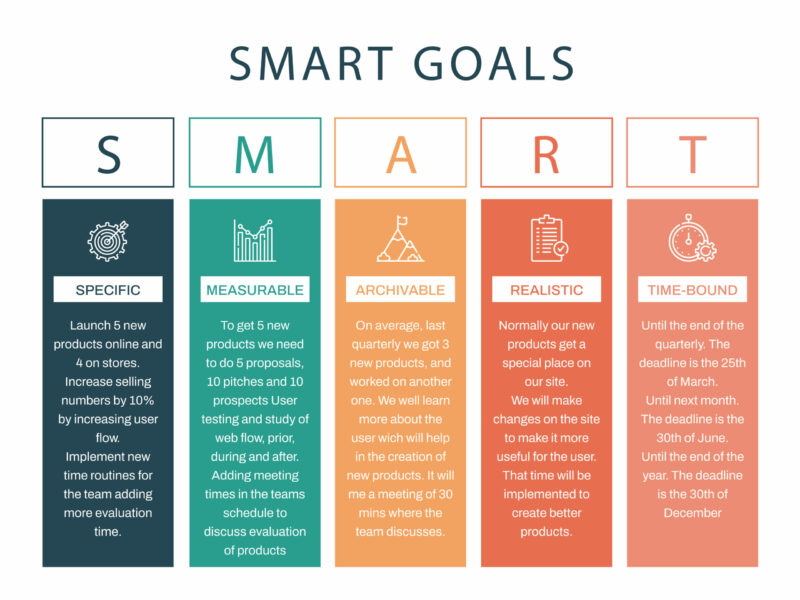
Budgeting
Budget can be very difficult to accurately ascertain in initial discussions with clients when I ask clients how much they are willing to invest. The answer is normally “As little as possible” or the budget is unrealistic and just doesn’t match their goals.
The advertising budget is affected by numerous factors:
- Your growth requirements, the amount and the rate of growth will play a big role in determining the budget. it’s commonly believed that a company that wishes to simply sustain its current size and market share should be spending around 5% of revenue on its overall marketing budget, however, a company with ambitious growth plans may need to double this to 10%. (When I say overall marketing budget I am referring to ALL costs involved in marketing such as marketing staff, other traditional marketing expenses etc and not just digital advertising.)
- Affordability, there’s always a bit of a time lag between marketing expenditure and the expected increase in income, especially for products with a long sales cycle, so you need to make sure you are not putting too much pressure on your vital cash flow. Be realistic with your budgets, you can always increase your expenditure over time.
- The competitive nature of digital advertising. Many digital platforms work on an auction format whereby you bid against your competitors for prime spots on their platforms. The more competitors that enter the auction the more expensive it can become and we have seen a huge increase in companies moving into digital marketing and advertising in recent years.
- The value of your product or service. The advertising platforms know the value of your products or services and charge accordingly for Clicks on your Ads, I have seen certain keywords costing hundreds of Euros per click.
- The size and nature of your potential market. A small B2B company may only have a few dozen potential customers within your area of operation requiring just two or three good leads per month whereas a B2C outlet may have many thousands of potential customers over a huge region nationally or internationally requiring hundreds of orders every month.
I advise you to start any new campaigns with a small test budget, first find out what works for you before you invest too much. One of the biggest advantages of Digital Advertising is the immediate flexibility it offers. You can alter your budget with the click of a button.
So start small, monitor the results, perform testing on different ads and platforms and optimise until you have sufficient data to make bigger decisions. Unless you are in a mad rush to market, rather wait a week or two until you have more accurate data to work with, it could save you a lot of money in the long run.
Ultimately it’s important to have a clearly defined CPA, cost per acquisition. This is the amount you are willing to spend to obtain a customer. If you know what each customer is worth to your business in full LTV and lifetime Value, then you should be able to calculate a fairly accurate CPA that’s acceptable to you.
The CPA will vary for different products, companies and industries depending on the gross margins, the value of the product or service and the competitive nature of the industry, there is no correct amount it just depends on how much you are willing to invest.
There is one unfortunate reality in business today. The company is willing to spend the most to acquire a customer wins.
Digital Advertising Platforms
I cover specific platforms in greater detail in other chapters so I’m not going to go into too much detail in this section other than to list some of the better-known platforms and give a brief description of each.
- Google Search Ads. With over 95% of Ireland’s Search Engine traffic, it’s still the number one platform for Search Ads.
- Google Display Network. A collection of over 2 million websites offering banner-style adverts.
- YouTube, A video platform owned by Google and rated as the world’s second-largest search engine and the most-used platform. A very strong presence across Age, Gender and Income groups.
- Affiliate sites. Similar to Google Display Network, a collection of websites that sell space for adverts on their sites.
- 3rd Party Websites. Websites that are specifically designed for the selling of products and services such as eBay, Amazon, Booking.com, and Expedia. There are many 3rd party websites created specifically to cater to certain products and industries.
- Bing Ads. (Microsoft). With only 2.8% of Ireland’s Search Engine traffic, it may offer less competition and be cheaper than Google.
- LinkedIn. A network of 2 million business professionals in Ireland. Offering strong B2B marketing and advertising with in-depth targeting parameters. Appeals to a higher income group. Over half of LinkedIn members log in less than a few times weekly.
- Facebook. The largest and most used social media platform in Ireland. 74% of users log in daily. 50% of its users are in the 25-44 age range. Least popular with teenagers. Offers a powerful advertising management platform.
- Instagram. Owned by Facebook, the second-largest and fastest-growing social media platform in Ireland can be linked to the Facebook Ads Management Platform. 63% of users log in daily.
- Whatsapp. Also owned by Facebook, the most popular messaging app in Ireland.
- Messenger. Also owned by Facebook, the second most popular messaging app in Ireland.
- Pinterest. A fast-growing image-sharing social media service is described as a virtual bulletin board. More popular with women and appeals to a higher-income group. Growing as a potential advertising platform.
- Twitter. A microblogging platform with the fourth-highest penetration of social media platforms in Ireland. More popular with the under ’30s.
- Snapchat. Strong with the younger generations, the under ’30s and teens with a 50/50 split by gender. Not strong with the higher income groups. Snapchat has lost some ground in Ireland recently.
- Tik Tok. A relatively new video-sharing platform. Fast-growing amongst the younger generations. 6% of Irish people now have an account and 43% use the platform daily.
This is by no means an exhaustive list of platforms that offer digital advertising, social media platforms are still popping up regularly and there are a few older ones I haven’t mentioned here, such as Tumblr, Viber and Reddit, because they’re not well known. Do you remember Google+ and Myspace proof that not all big-name platforms endure?
PPC vs CPM
There are two common costing models on the majority of digital advertising platforms each one serves to achieve a slightly different goal:
PPC – Pay per Click.
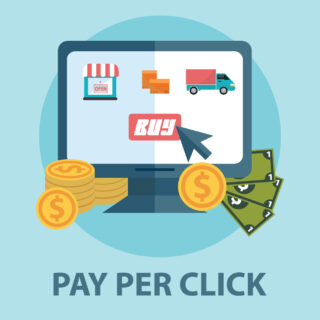 With this model, you only pay if someone clicks on your advert no matter how many times your advert is displayed.
With this model, you only pay if someone clicks on your advert no matter how many times your advert is displayed.
PPC works by setting a daily budget, this is how much you are willing to spend each day per ad or campaign. Your monthly budget is calculated by multiplying your daily budget by 30.4.
Most platforms may use less than or more than your daily budget depending on the daily demand, but the average daily spend will be averaged out so as not to exceed your monthly budget.
Secondly, you are required to set a maximum bid amount. This is the maximum amount you are willing to pay for a Click on your advert. This doesn’t mean that you will pay that amount for every click. Many clicks will cost less depending on what your competitors have bid, but you will never be charged more than your maximum bid amount.
There are a couple of important things you need to bear in mind when setting a maximum bid amount:
- It’s an auction where the highest bid normally gets the more prominent position, if you want that number 1 top-of-page position for your ads then you may have to set a higher bid.
- Not all companies have unlimited budgets the higher you bid the quicker your daily budget may be exhausted. Let’s say you have a €100.00 daily budget set and are willing to spend €20.00 per click. Your daily budget could be spent on just 5 clicks before 9 am. Once your daily budget has been used your ads will not be displayed again until the next day resulting in you missing out on a lot of potential business.
CPC can become expensive, especially in a highly competitive environment or if you are marketing a product or service of high value.
CPC is great to use if you are selling a specific product when you know there is a good chance that a click may lead to an actual sale such as online e-commerce or Time-Based Campaigns where you have just launched a new product or service.
CPC is often used in Lead Generation where conversions are a priority.
CPM – Cost per Mille (Mille is Latin for Thousand)
Cost per Mille is more associated with Display ads where Brand Awareness or new product awareness is the primary goal as opposed to the Click Through Rate.
CPM is also good for campaigns where a naturally high click-through rate is expected where CPC would be the more expensive option.
With CPM you pay a certain amount per thousand impressions of your advert irrespective of how many people click on your ad.
An impression is when your advert is displayed on the screen of a user’s device. It doesn’t mean that the advert was seen by the user or interacted with in any way. It may only have been visible for a split second as the user scrolled down the page.
The problem with CPM is that it is hard to accurately determine a Return On Investment.
Targeting
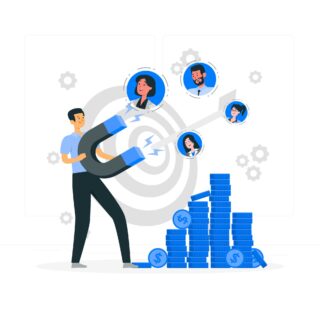 The basics of marketing or advertising are to get the right message to the right person at the right time. If you don’t know who the right person is, how are you going to target them?
The basics of marketing or advertising are to get the right message to the right person at the right time. If you don’t know who the right person is, how are you going to target them?
It’s vital to know who your ideal customer and buyer’s persona is to target the right person correctly, getting your targeting wrong will render your campaigns less effective and waste your valuable marketing budget.
Knowing who your customers are in terms of demographics, Interests and motivations will greatly assist in choosing the correct platforms to advertise on. Different platforms appeal to different age groups, genders and income groups. Some platforms are more popular in certain geographical areas than others.
Digital marketing platforms offer extremely powerful targeting tools that enable marketers to run campaigns according to very specific goals. Tightly targeted for Sales and Conversions and more broadly targeted to attract new customers in the early stages of the buyer’s cycle.
Some of the more mature platforms offer the most powerful targeting tools including some of the following targeting options offered by LinkedIn:
- Language
- Location
- Job Function
- Seniority
- Job Title
- Years of Experience
- Skills
- Company Name
- Company Industry
- Company Growth Rate
- Company Category
- Company Size
- Education
- Fields of Study
- Interests
- Member Traits
- Groups
- Age
- Gender
- Audience Expansion & Lookalike Audiences
What makes the targeting options so powerful is the ability to combine more than one option and make use of the AND & OR functions. For example, you can target an IT manager OR Head of IT with 5+ years of experience in either the Agriculture OR Marine industry. As you can see this enables you to get extremely specific with your targeting.
Naturally, not all platforms will offer such a wide variety of Targeting options. Most social media platforms do not collect Company and Professional data as it’s not of relevance to its members, they will offer only the basic personal details and demographics such as Gender, Age Interests etc.
Ad Types
The various platforms offer a range of different ad types each one suited to a different purpose. I’m not going to go into too much detail as every platform is slightly different in terms of the ad types it offers and the specifications of each ad type in terms of character limits, image sizes, video lengths etc.
I strongly advise you to check the requirements and specifications on each platform before creating an ad as image, video shapes, sizes, orientations and durations will vary from platform to platform. Specifications and ad types are also subject to change from time to time.
- The basic text ads you will find in Google Search Network are the listings on the Google Search Results page marked with the word Ad in the top left-hand corner of the Advert. These ads are often at the top and/or bottom of the page. LinkedIn also offers a basic text ad including a small image most often shown on the top right-hand corner of your LinkedIn feed on a PC, LinkedIn text ads are not shown on mobile devices. Each platform has its limit on the number of characters. These ad formats are the quickest and easiest to set up and are great for lead generation.
- The image ad allows for a single image, separate text and a link to your offer. Some platforms only allow a certain amount of text in the image itself. The size of the image file, file type and orientation vary from platform to platform.
- The video ad – Considering that YouTube is the second-largest search engine in the world it would make sense to invest in Video Advertising, videos are also very popular and engaging on numerous social media platforms. Keep them short and to the point, you don’t have a lot of time to get your message across, roughly 6 – 8 seconds before people lose interest and move on.
- Carousel – a collection of images similar to the image ad
- Boosted Post – A quick way to get more exposure for a popular post on Social Media.
- Sponsored Inmail – popular on LinkedIn, a basic email that is sent to targeted individuals, a great way to get a message across.
- Shopping Ads – These are the ads that often appear on the top of the page on Google after searching for specific products, these will include an image, a Title, a Price, the Company name and a Rating. Clicking on these will take you straight to the product on the eCommerce website. Google also offers a completely separate section for shopping under the shopping tag.
Measuring and KPIs
The KPIs that would be tracked will depend on the purpose of the overall campaign, a Brand Awareness campaign will have very different goals from a Lead Generation or e-commerce campaign and will therefore also have very different KPIs (Key Performance Indicators)
Ultimately the KPIs that would be tracked will include relevant Measurements along the buyer’s journey or the sales funnel.
At the top of the funnel, we will be interested in the number of impressions an advert is receiving and how many people are clicking on the ad – CTR (Click Through Rate) and the costs involved in each of these, this will give us a good idea if the ad is getting the desired exposure and if the message is resonating with our target market.
In the middle of the funnel, we would be more interested in Engagement statistics such as Time on Landing Page – Bounce Rate – If it’s a video ad then we would like to know how many views and how long the video is being watched, are people just viewing a few seconds and dropping off or watching the video through to the end. Is the offer well received?
At the bottom of the funnel, we will be interested in Conversions, how many people do what is expected of them, such as make a purchase or become a SQL (Sales Qualified Lead) and what the costs involved such as CPA – Cost per Acquisition or Lead – ROI – Return in Investment and ROAS – Return on Ad Spend and what is the overall Conversion Rate?
The trick is to track just enough KPIs to be able to measure the overall success of any campaign and enable corrections where necessary, but not to track too many as to become overly complicated and cumbersome to understand, so don’t overanalyse.
Features of a Good Digital Advertising Campaign
The first and most important feature of any Digital Advertising Campaign is to know who your customer is, your Buyer’s Persona, and to target them correctly. If you don’t know who your ideal customer is it’s a bit like going on a journey with no destination – you will never get there.
Once you know exactly who your Buyers Persona is you will then know what the messaging should be, what platforms to advertise on and who to target. Accurate targeting should include not just Demographics but Psychographics too.
An effective advertising campaign should include adverts that cover all parts of the Buyers Journey from initial Brand Awareness such as Banner and Social Media ads to highly targeted search ads and Re-Marketing at the bottom end of the funnel. It may also include some form of Lead Generation and automated emails depending on the nature of the product or services you provide.
Having all the different aspects of an advertising campaign running simultaneously reinforces each of the parts and improves the overall conversion rate. It’s unlikely that someone will buy from you based on one interaction, but if a potential customer sees your Banner Ad performs a Google Search for your product clicks on your search ad and then is reminded about your company by seeing Re-marketing ads he is much more likely to complete a purchase.
The complexity and length of the sales cycle will play a large role in the overall design of each campaign. It doesn’t matter who you are, or what product or service you sell, not every person you attract through your advertising will buy immediately so it’s important to build an email list for further nurturing and communication.
Benefits of Paid Digital Advertising
The benefits of Digital Advertising are numerous:
- Digital Advertising is instant, from the moment you activate and the Ads have been approved they will start showing. This is great for start-ups or short-notice campaigns that require quick results. Digital Advertising can also be used to complement Content Marketing and SEO.
- Campaigns can be optimised on the fly, unlike more traditional methods paid campaigns can be changed at any time, as often as you like, and the changes are instant.
- Real-time data makes tracking and improving campaigns more effective enabling errors or poor-performing campaigns to be fixed quickly.
- Digital advertising allows for greater testing and experimentation resulting in ever-improving results.
- Digital advertising is extremely cost-effective because you only pay for results, you only pay when someone takes a desired action, such as Clicking on your advert.
- The ability to highly target a specific “Buyers Persona” means you are getting your message to the right person who is more qualified to take the desired action.
- Search Ads offer the advantage of being seen by the right person at the “Right Time” when they are searching for the products or services you provide and are thus more likely to do business with you. 89% of buyers’ journeys begin with a search engine.
- Using display Ads not only creates Brand Awareness but also helps to improve search results and conversion rates. ( 27% of consumers searched for a business after seeing its display ad, and there was a 59% lift in conversions when users conducted a search related to a display ad) Adding Display Re-marketing on top of this further improves results.
Contact Us for your Digital Advertising Requirements

